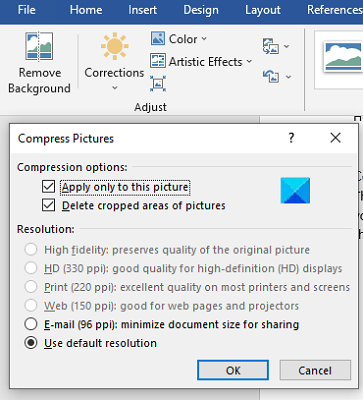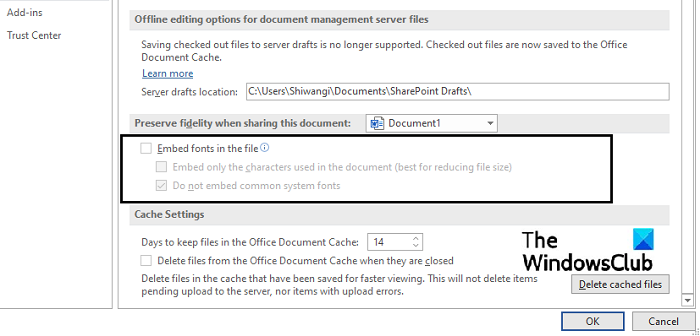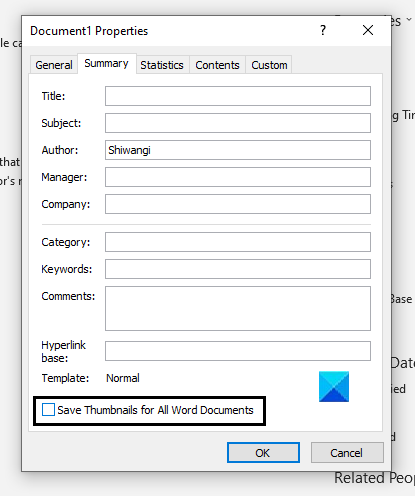There is no need to reiterate just how important Microsoft Word is. Word documents come into use almost everywhere and thus, we must make sure they are applicable at all times. One problem people may run into with Word documents is their file size; it may be too big sometimes. Although it’s not an issue people face very frequently, it helps to know what you should do if you ever want to reduce the size of your Word document. So, in this article, we will discuss all measures you can implement to reduce the file size of your Word document.
How to reduce the file size of a Word document?
Here’s all you can do to compress and reduce the size of your Word document.
- Compress images in the document
- Don’t embed fonts
- Save it as a .docx file
- Don’t store a thumbnail for your document
1] Compress images in the document
There is only so much drive space that words on a document may be eating up, it is the pictures that you’ve uploaded in your document which eat up the space. A method to remediate that is to compress these images. Here’s how media items can be compressed in MS Word:
- Click on a picture in your document
- Once it is selected, a set of Picture Formatting options will appear on the Word taskbar. In there you’ll see an option by the name of Adjust where there is a setting to compress images. Click on it
- This will open a small, separate dialog box. The first thing you have to do is to uncheck Apply only to this picture box because, in order to effectively reduce the size, we would have to apply the changes to all the pictures in the document.
- Keep the Delete cropped areas of pictures box selected. Please note that the areas deleted here will be beyond restoration
- Under Resolution, most of the options will be blurred out. You are recommended to select ‘Use default resolution’

Another tactic that may just come into play here is inserting pictures into Word as media objects instead of simply copying and pasting them. It has been observed that the file size is smaller when the former is done.
2] Don’t embed fonts
Embedded fonts can also contribute to larger file sizes, so disabling the option to do so can be helpful. Here’s how you can do that:
- Click on File from the top-right corner on MS Word > Options and from the left sidebar click on Save
- Under Preserve fidelity when saving this document, ensure that the Embed fonts in the file box are left unchecked
- If you do feel the need to embed fonts, check that box but further select Embed only the characters used in the document (best for reducing file size) and Do not embed common system fonts

This should help you greatly with the file size.
3] Save it as a .docx file
Microsoft introduced the .docx format in Word 2007, so if you’re someone who’s still using an older version than that you can try changing your file format, which I’m guessing is .doc to .docx. Go to File and then Info. Here, you’ll see a Convert option. Click on it and click on Ok in the subsequent prompt. The .docx file essentially acts as a .ZIP folder which is able to compress a substantial amount of data in a file of a rather small size.
4] Don’t store a thumbnail for your document
This is not something you would find most people doing, but it is worth mentioning while we’re on the subject. On MS Word, you can save a thumbnail image for a Word document, so that when it is viewed in the File Manager, you’re able to get a preview and better identify which file is which. If this option is found to be turned on, you could see a substantial increase in your file size. Follow the steps below to make sure that isn’t so and if it is, then how it can be disabled:
- Click on File > Info. Click on the Properties drop-down and further select Advanced Properties
- From this next dialog box, un-check the Save thumbnails for all Word documents box and save this change by clicking on Ok

There’s a slight chance this option may be enabled on your system. An alternative way to disable this is from the Save As file manager box where you can make sure that the ‘Save thumbnail’ box isn’t selected.
If none of the aforementioned methods help and you need to reduce the size of your Word file a bit more, you can always compress it. Different compression levels reduce size and impact document quality differently, so it’s recommended that you do it smartly.
What is the maximum size of a Word document created?
The maximum file size for a Microsoft Word document is 512 MB. The maximum text in the file is 32 MB. So if the file contains graphics, the maximum file size can be larger than 32 MB. After you reach the limit, you may experience problems while saving or working with the file. Word really has no maximum page limit – it all depends on the file size.
How to reduce Word files online free?
Some of the most commonly used online tools for Word document compression are SmallPDF and WeCompress. You can also use a free file compression software.
We hope that this post was of help to you!